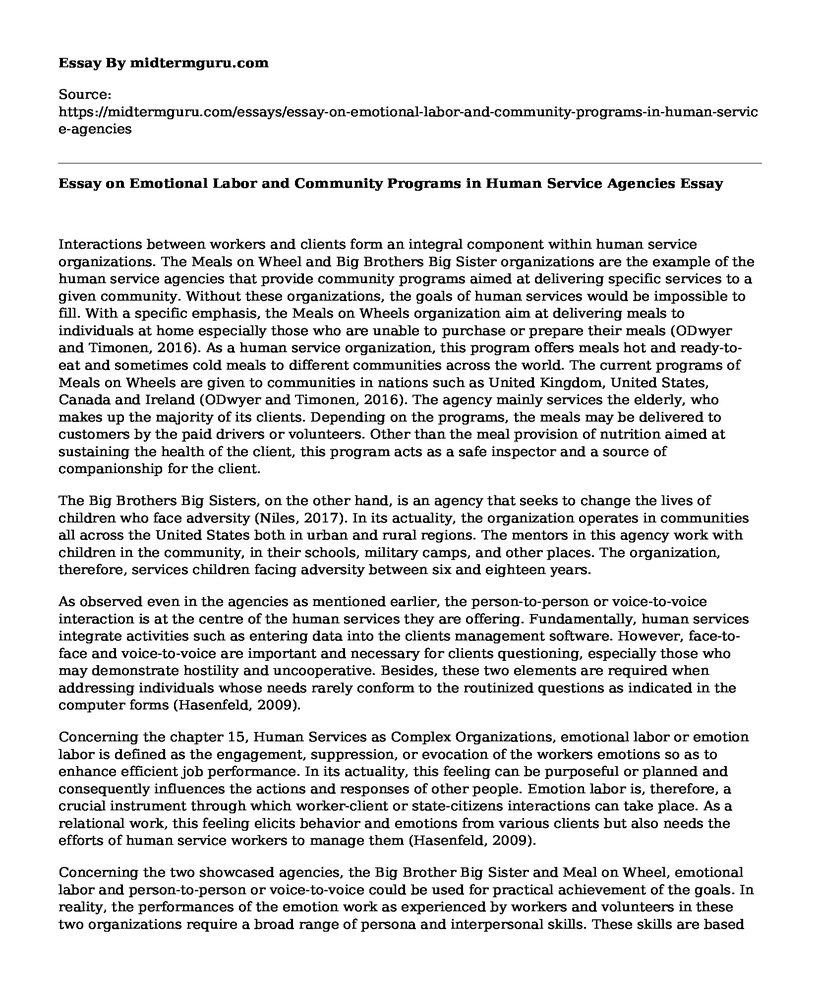Interactions between workers and clients form an integral component within human service organizations. The Meals on Wheel and Big Brothers Big Sister organizations are the example of the human service agencies that provide community programs aimed at delivering specific services to a given community. Without these organizations, the goals of human services would be impossible to fill. With a specific emphasis, the Meals on Wheels organization aim at delivering meals to individuals at home especially those who are unable to purchase or prepare their meals (ODwyer and Timonen, 2016). As a human service organization, this program offers meals hot and ready-to-eat and sometimes cold meals to different communities across the world. The current programs of Meals on Wheels are given to communities in nations such as United Kingdom, United States, Canada and Ireland (ODwyer and Timonen, 2016). The agency mainly services the elderly, who makes up the majority of its clients. Depending on the programs, the meals may be delivered to customers by the paid drivers or volunteers. Other than the meal provision of nutrition aimed at sustaining the health of the client, this program acts as a safe inspector and a source of companionship for the client.
The Big Brothers Big Sisters, on the other hand, is an agency that seeks to change the lives of children who face adversity (Niles, 2017). In its actuality, the organization operates in communities all across the United States both in urban and rural regions. The mentors in this agency work with children in the community, in their schools, military camps, and other places. The organization, therefore, services children facing adversity between six and eighteen years.
As observed even in the agencies as mentioned earlier, the person-to-person or voice-to-voice interaction is at the centre of the human services they are offering. Fundamentally, human services integrate activities such as entering data into the clients management software. However, face-to-face and voice-to-voice are important and necessary for clients questioning, especially those who may demonstrate hostility and uncooperative. Besides, these two elements are required when addressing individuals whose needs rarely conform to the routinized questions as indicated in the computer forms (Hasenfeld, 2009).
Concerning the chapter 15, Human Services as Complex Organizations, emotional labor or emotion labor is defined as the engagement, suppression, or evocation of the workers emotions so as to enhance efficient job performance. In its actuality, this feeling can be purposeful or planned and consequently influences the actions and responses of other people. Emotion labor is, therefore, a crucial instrument through which worker-client or state-citizens interactions can take place. As a relational work, this feeling elicits behavior and emotions from various clients but also needs the efforts of human service workers to manage them (Hasenfeld, 2009).
Concerning the two showcased agencies, the Big Brother Big Sister and Meal on Wheel, emotional labor and person-to-person or voice-to-voice could be used for practical achievement of the goals. In reality, the performances of the emotion work as experienced by workers and volunteers in these two organizations require a broad range of persona and interpersonal skills. These skills are based on the talent and individual characteristics but can be shaped and perfected through practice and training (Hasenfeld, 2009). The face-to-face and voice-to-voice on the part of the showcased organizations will require the workers to affectively sense and flexible to their emotions, as well as those of their clients. Finally, the social workers in both agencies will need to sense the emotions of the other people through communication and intuition. They will be able to generate the desired emotional responses from their clients and thereby get the opportunity to know their needs to assist them appropriately.
References
Hasenfeld, Y. (2009). Human services as complex organizations. London: SAGE
Niles, N. J. (2017). Basics of the U.S. health care system. Burlington, MA : Jones & Bartlett Learning
ODwyer C., and Timonen, V., (2016): Role and Future Development of the Meals-on-Wheels Service for Older People in Ireland. National Council on Ageing and Older People. Retrieved from www.ncaop.ie/publications/research/reports/104_Role_Dev_MOW_Services.pdf
Cite this page
Essay on Emotional Labor and Community Programs in Human Service Agencies . (2021, Jul 02). Retrieved from https://midtermguru.com/essays/essay-on-emotional-labor-and-community-programs-in-human-service-agencies
If you are the original author of this essay and no longer wish to have it published on the midtermguru.com website, please click below to request its removal:
- Evaluation Essay on Blockbuster Company
- Research Paper on Weatherford International Ltd
- Essay Sample on American Express App
- IBM's Fight for Market Dominance in Global Data Era - Essay Sample
- Salary Increase and Training Program: Key to Employee Retention - Essay Sample
- Frank Rainsford: Achieving Entrepreneurial Success Through Effective Leadership - Essay Sample
- Australia Post: Delivering Quality Services Since 1809 - Essay Sample







